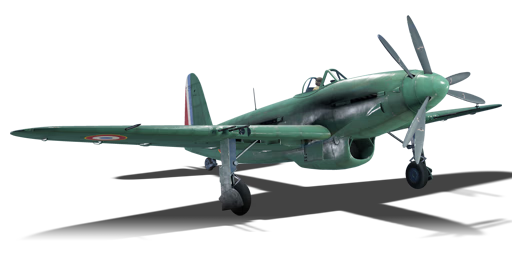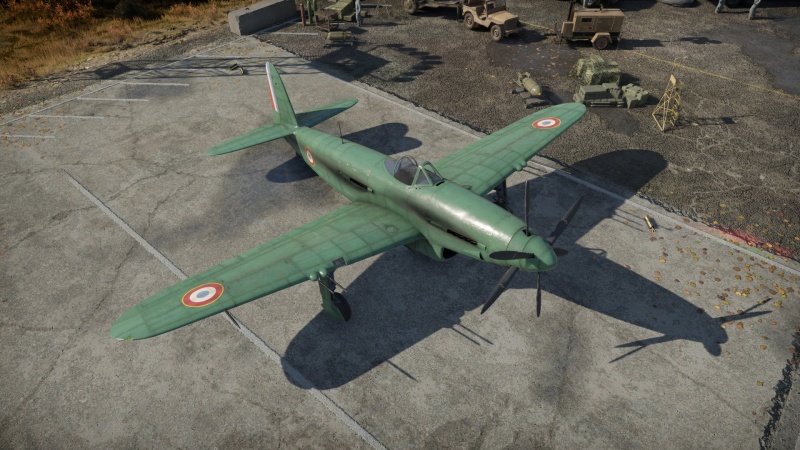VB.10C-1
| This page is about the French twin-engine fighter VB.10C-1. For the other version, see VB.10-02. |
Contents
Description
The VB.10C-1 is a rank French twin-engine fighter with a battle rating of (AB), (RB), and (SB). It was introduced in Update 1.73 "Vive la France".
General info
Flight performance
| Characteristics | Max Speed (km/h at 7,000 m) |
Max altitude (metres) |
Turn time (seconds) |
Rate of climb (metres/second) |
Take-off run (metres) | |||
|---|---|---|---|---|---|---|---|---|
| AB | RB | AB | RB | AB | RB | |||
| Stock | 679 | 659 | 25.4 | 26.5 | 11.7 | 11.7 | 700 | |
| Upgraded | 739 | 710 | 22.8 | 24.0 | 19.3 | 15.4 | ||
Details
| Features | ||||
|---|---|---|---|---|
| Combat flaps | Take-off flaps | Landing flaps | Air brakes | Arrestor gear |
| ✓ | ✓ | ✓ | X | X |
| Limits | ||||||
|---|---|---|---|---|---|---|
| Wings (km/h) | Gear (km/h) | Flaps (km/h) | Max Static G | |||
| Combat | Take-off | Landing | + | - | ||
| 498 | 469 | 320 | ~11 | ~6 | ||
| Optimal velocities (km/h) | |||
|---|---|---|---|
| Ailerons | Rudder | Elevators | Radiator |
| < 380 | < 380 | < 540 | > 340 |
| Compressor (RB/SB) | ||
|---|---|---|
| Setting 1 | ||
| Optimal altitude | 100% Engine power | WEP Engine power |
| 3,000 m | 1,200 hp | 1,536 hp |
| Setting 2 | ||
| Optimal altitude | 100% Engine power | WEP Engine power |
| 8,000 m | 1,120 hp | 1,433 hp |
Survivability and armour
- 50 mm Bulletproof glass in front and rear of the cockpit.
Modifications and economy
Armaments
Offensive armament
The VB.10C-1 is armed with:
- 4 x 20 mm Hispano 404 cannons, wing-mounted (150 rpg = 600 total)
The four cannons are arranged in bundles of two mounted in each wing. Each is armed with the same amount of ammunition, which means that all guns will fire with each other until empty.
Usage in battles
The VB.10C-1, like most heavy fighters, is reliant on side climbing to engage enemy fighters, however this isn't the only way to play the VB.10C-1, if you decide to side climb and wait for enemy planes to drop down to lower altitudes they will find themselves in peril when a experienced pilot in a VB.10C-1 comes booming past with its quick dive rate and deadly armament of 4 x 20 mm Hispano 404 cannons. The best tactic when flying solo is Boom & Zoom and play as the team's support fighter, as its great acceleration and heavy weight can allow you to make fast attacks against unsuspecting enemy fighters at lower altitudes that are pre-occupied with fighting friendly aircraft. The heavy weight can also help carry the planes speed when extending and helps retain a bit of speed when going back into a climb, be aware however that the VB.10C-1's size and weight makes it a considerable target if you happen to miss your engagement. The best tactic when flying in a group of two or more is to help teammates that are struggling in a dogfight with enemy fighters, as a large target the VB.10C-1 can distract enemy fighters and outrun most using its advantage in weight and energy which allows teammates to slide onto the enemies six o'clock and finish them off.
If you need to do a quick turn, set combat flaps and reduce the power of the engine to around 50%, then turn and close the combat flaps when half-finished with your manoeuvre. Be aware that turning in the VB.10C-1 is a way to intentionally or unintentionally bleed off any built-up energy. Conserve energy when possible in the VB.10C-1 as it lacks the capabilitys to dogfight other fighters in fast or slow turning engagements.
Manual Engine Control
| MEC elements | ||||||
|---|---|---|---|---|---|---|
| Mixer | Pitch | Radiator | Supercharger | Turbocharger | ||
| Oil | Water | Type | ||||
| Controllable | Controllable Not auto controlled |
Controllable Not auto controlled |
Controllable Not auto controlled |
Separate | Controllable 2 gears |
Not controllable |
Pros and cons
Pros:
- Very fast at medium to low altitudes
- Average climb rate (inferior to contemporary German/Italian counterparts)
- Decent ammo count
- Good turn rate (can manoeuvre with Bf 109s)
- Brutal acceleration in a dive
- Quite strong combat flaps
- Good horizontal energy retention
- Good cockpit visibility (important for simulator battle players)
- If one engine/propeller fails the VB still flies very well with the other one; so you can easily return to the airfield for repairs
Cons
- Bad acceleration rate (except in a dive)
- Awful vertical turner
- Rudder is unresponsive at high speeds
- Very heavy feeling in the air
- Stock belts are unimpressive
- Stock guns are inaccurate
- Similar to Do-335, guns can be difficult to align at high speeds
- Bad roll rate is made even worse with unresponsive rudder
- Guns are mounted far outside the centre, so it's hard to hit small targets with full force (try convergence point at ~600 m)
- All guns have a 150 round magazine, if one gun is empty... all guns are empty; so watch your ammo stats
History
In January 1937 Arsenal were given a contract to develop a twin-engined heavy interceptor built from wood, powered by two 590 hp Hispano-Suiza 12X engines mounted in tandem inside the fuselage, driving co-axial propellers in the nose. Work on the VG 10 was abandoned in June 1937 in favour of the VG 20, which was essentially similar but powered by two 900 hp Hispano-Suiza 12Y engines. The VG 20 was abandoned in turn in January 1938, but the design work and studies were used for the design of the all-metal VB 10. For research in the development of the VG 10 and VG 20, Arsenal designed and built the VG 30 powered by a single 690 hp Hispano-Suiza 12X engine, which in turn led to the high-performance fighter prototypes of the VG 30 series.
Although the aircraft was first designed (and indeed ordered) in 1940, little progress was made during France's occupation, and the prototype did not fly until after VE day. By then, it was already apparent that the future of the fighter lay with jet power, but development of the VB 10 continued as a safety net for France's nascent jet fighter programmes. In December 1945, a contract for 200 machines was placed by the French government, the first of which flew on 3 November 1947. By the time the fourth had been delivered in September 1948, the entire order was cancelled, with the French Air Force relying on surplus British and American fighters to tide it over until domestically produced jet fighters appeared shortly thereafter.
Source: https://en.wikipedia.org/wiki/Arsenal_VB_10
Media
See also
Links to the articles on the War Thunder Wiki that you think will be useful for the reader, for example:
- reference to the series of the aircraft;
- links to approximate analogues of other nations and research trees.
External links
| Arsenal Aeronautical (Arsenal de l'Aéronautique) | |
|---|---|
| Fighters | VB.10-02 · VB.10C-1 |
| V.G.33C-1 | |
| France twin-engine fighters and strike aircraft | |
|---|---|
| Twin-engine fighters | Potez 630 · Potez 631 · VB.10C-1 · VB.10-02 |
| Strike aircraft | Br.693AB2 · ▄AD-4 · ▄AD-4NA |
| Netherlands | |
| Twin-engine fighters | ◗Fokker G.IA |
| Strike aircraft | ◘Firefly F.Mk.IV |





